|
Bryogeography
Endemic Australian bryophytes
What do we mean by an endemic species? Here endemic is defined as known only from Australia or, if known from outside Australia, there's strong evidence that it has been spread from Australia by humans. Some of the species may have evolved in Australia after the break-up of Gonndwana. Some may have moved to Australia from elsewhere and become extinct in their "original" homes. Others may have been very widespread in an area that included ancient Australia but have disappeared from all those other areas. So there are various ways in which today's endemic species could have arisen but this page won't go into hypotheses for the various examples given below.
This page will be devoted to showing you the distribution patterns of some endemic Australian bryophytes. Many endemic species are known from limited areas. That is undoubtedly a reflection of insufficient bryological exploration and future field work will undoubtedly show a large proportion of such species to be more widespread. On the other hand, there are also many endemic species that are known over wide areas – some sparsely distributed over their ranges, others densely.
The aim of this page is to illustrate various distribution patterns with a few examples, rather than an exhaustive list, of each. The examples will mostly be at the species level, with only a few comments about the higher classification categories of genus and family. There are many PROBLEMS AND PUZZLES in Australian bryogeography and by following that link you can find out more. That also gives more context to the information on this page and is essential reading for a proper understanding of the issues of Australian bryogeography.
Though non-endemic species won't feature on this page it's worth noting that the non-endemic bryophytes found in Australia show a similar variety of distribution patterns within the country. The Australian distributions of a few non-endemic species feature in the PROBLEMS AND PUZZLES page.
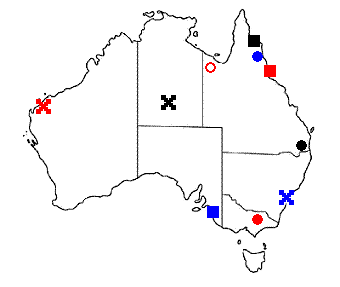 Species with restricted distributions
Species with restricted distributions
A number of endemic bryophytes have limited geographic ranges and the following map shows the distributions of several such species. Of the species shown on the map,
Telaranea quadristipula (![]() ) is a leafy liverwort,
) is a leafy liverwort,
Fossombronia laciniata (![]() ) is a thallose liverwort
) is a thallose liverwort
and the rest are mosses:
Archidium minutissimum (![]() ),
),
Archidium thalliferum (![]() ),
),
Brachydontium intermedium (![]() ),
),
Ephemerum furcatum (![]() ),
),
Fissidens badyinbarus (![]() ) ,
) ,
Macromitrium dielsii (![]() ),
),
Pottia latzii (![]() ),
),
Stoneobryum bunyaense (![]() )
)
The known ranges of these species are very limited. For example, Archidium minutissimum is known only from a few sites all very close to Cooktown and Fissidens badyinbarus has been found only from Hinchinbrook Island off the north Queensland coast. Stoneobryum bunyaense, known only from one site in the Bunya Mountains in south-east Queensland, where it grows on the high branches of eucalypts. The only other species in the genus, Stoneobryum mirum, is found in South Africa. Ephemerum furcatum and Fossombronia laciniata are only known from the sites at which the original specimens were collected. For most of those species detailed descriptions were first published after 1980. That's not the case with Telaranea quadristipula, but a detailed description, based on a thorough re-examination of the one known specimen, was published in 2004. So the issue with these species is neither the vague 19th century descriptions nor the lost specimens mentioned in the OLD LITERATURE AND NEW IDEAS page. At present we can only note the places where those species have been found, but can neither deduce anything about their further distributions, nor assume that they really are so restricted in area. There's just too little evidence on which to erect a hypothesis so they remain as puzzles for the moment.
The species listed above represent extreme cases of limited distributions. There are also many endemic species, still known from limited areas, but more extensive than those of the above species.
The paper given in the following reference button notes about 25 species of moss that are endemic to the area of Queensland roughly between Townsville and Cooktown and encompassing both the coastal lowlands and the nearby parts of the Great Dividing Range. Many of those 25 are known from very limited areas and you've seen some examples above. However, others are a little more widespread. One example is Fissidens oblatus, known from lowland areas near Cairns and Cooktown and (away from the coast) near Irvinebank on the Atherton Tableland. Another is Hypnodendron comatulum, known from a number of sites in the Innisfail-Port Douglas area![]() .
.
The leafy liverwort Telaranea tasmanica is known from a number of sites in Tasmania. The moss Ambuchanania leucobryoides, the only species in the genus Ambuchanania, is known only from Tasmania. It has been found at Port Davey and on the Central Plateau. Two other mosses confined to Tasmania are Pleurophascum grandiglobum ![]() and Tayloria gunnii
and Tayloria gunnii ![]() . The former was once thought to occur in New Zealand as well, but a detailed study of the New Zealand material concluded that the Pleurophascum in New Zealand was a different species. The third species in the genus, Pleurophascum occidentale, is found only in south-west Western Australia. A Pleurophascum stem, with leaves suggestive of Pleurophascum grabdiglobum, was found on Stewart Island in the far south of New Zealand. However, given the poor quality of the material, the authors of the paper in the following reference button were unable to take the identification beyond genus. There are many bryological affinities between Tasmania and southern New Zealand, so future work may yet find this Pleurophascum in New Zealand
. The former was once thought to occur in New Zealand as well, but a detailed study of the New Zealand material concluded that the Pleurophascum in New Zealand was a different species. The third species in the genus, Pleurophascum occidentale, is found only in south-west Western Australia. A Pleurophascum stem, with leaves suggestive of Pleurophascum grabdiglobum, was found on Stewart Island in the far south of New Zealand. However, given the poor quality of the material, the authors of the paper in the following reference button were unable to take the identification beyond genus. There are many bryological affinities between Tasmania and southern New Zealand, so future work may yet find this Pleurophascum in New Zealand![]() .
.
The moss Archidium stellatum is found in grasslands or lightly forested areas of Victoria and south-eastern South Australia and Philonotis slateri is a moss found in north-eastern New South Wales and south-eastern Queensland. The description of the leafy liverwort Austrolejeunea occidentalis was first published in 2006. The species is only known from a small number of coastal and slightly inland areas of south-west Western Australia, spread roughly between Albany and the Indian Ocean.
It is likely that at least some of the species that are currently known from limited areas will turn out to have wider distributions. That seems a very reasonable assumption for any species so far known from just one location. Some of the currently known distributions are likely to be more an indication of not enough searching than an indication of the true range of the species in question. That would be so especially for some of the tinier or more cryptic species. On the other hand the sporophytes of species such as Tayloria gunnii and Pleurophascum grandiglobum are so striking and easily spotted that you'd expect those species would already have been found outside Tasmania if they do occur outside that state. That doesn't prove that they are confined to Tasmania but it would seem a highly plausible hypothesis.
Widespread species
In contrast to the species noted in the previous section, the species listed in this section are widespread. Many are distributed more or less uniformly between the extremities of their ranges while some show significant disjunctions.
Along the Divide
In eastern mainland Australia the Great Dividing Range runs parallel to the coast, from north Queensland to central Victoria. On the coastal side of that range there is a narrow band of low-lying land. Together, the Great Dividing Range and the narrow coastal band provide about 3,500 kilometres of diversely vegetated, well-watered land, varying from sea-level to over 2,000 metres in altitude and from cool-temperate to tropical in climatic conditions. Given the variety of habitats along the Divide, it's not surprising that it is home to many species and that a number are found only along the Divide.
The mosses Dawsonia longiseta ![]() and Dawsonia polytrichoides are found from Victoria to north Queensland and from sea level to altitudes of over 1000 metres along the Great Dividing Range, with Dawsonia longiseta also found in south-eastern South Australia. There have been reports of the two species from Tasmania but these need confirmation. The Great Dividing Range is home to a number of other endemic mosses as well, though not all extend as far along the Divide as do the two Dawsonia species mentioned above. Macromitrium aurescens is found from near Townsville in north Queensland to a little north of Newcastle in New South Wales, and Macromitrium caloblastoides is similar, though it reaches the south coast of New South Wales. The following maps show the distributions of, from left to right, Dawsonia longiseta, Dawsonia polytrichoides, Macromitrium aurescens and Macromitrium caloblastoides.
and Dawsonia polytrichoides are found from Victoria to north Queensland and from sea level to altitudes of over 1000 metres along the Great Dividing Range, with Dawsonia longiseta also found in south-eastern South Australia. There have been reports of the two species from Tasmania but these need confirmation. The Great Dividing Range is home to a number of other endemic mosses as well, though not all extend as far along the Divide as do the two Dawsonia species mentioned above. Macromitrium aurescens is found from near Townsville in north Queensland to a little north of Newcastle in New South Wales, and Macromitrium caloblastoides is similar, though it reaches the south coast of New South Wales. The following maps show the distributions of, from left to right, Dawsonia longiseta, Dawsonia polytrichoides, Macromitrium aurescens and Macromitrium caloblastoides.
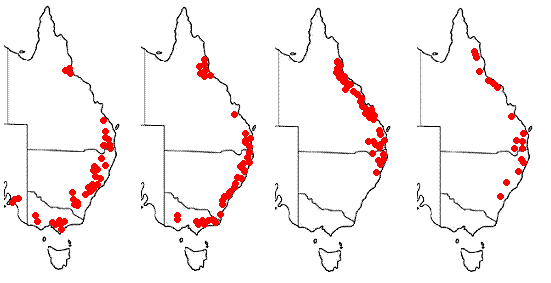
The leafy liverworts Spruceanthus thozetianus and Thysananthus australis are found along the coastal band between northern Queensland and southern New South Wales. They are not equally widespread and, in contrast to the mosses mentioned in the previous paragraph, the these two liverworts show a much sparser distribution along the Divide. Another leafy liverwort, Telaranea verruculosa, was described as a new species in a monograph published in 2004. The species is known only from north Queensland, at a few locations from Cardwell to Kuranda and from King Billy Landing near Cape York. That's a total distance of about 800 kilometres. The following maps show the distributions of, from left to light, Spruceanthus thozetianus, Telaranea verruculosa and Thysananthus australis.
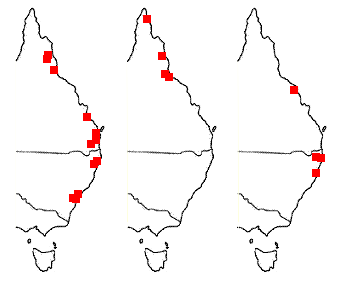
Though all of these liverworts have marked gaps in their distributions, those gaps are likely to be a reflection of the lack of specimen collecting in the intervening areas rather than an indication of natural disjunctions. There are what should be suitable habitats in the intervening areas. It is also possible that there already are herbarium specimens of some of these species from other areas, but that those specimens have been mis-identified. There has been some confusion in the taxonomy of the leafy liverworts. With the better modern understanding of the differences between genera and species, many older herbarium collections have been found to be mis-named. This is one of the issues dealt with in the PROBLEMS AND PUZZLES page.
Inland
The moss Ephermerum cristatum is found in many of the non-montane parts of Australia. It can be found near the coast and well inland. Amongst the liverworts the thallose species Asterella drummondii ![]() is widespread in Australia and found on bare soil in a variety of habitats. It is found from some of the dry inland areas to the coast, in both natural and urban settings. For example, it is very common in Canberra. The map (below left) shows the distribution of Ephemerum cristatum (red dots) and Asterella drummondii (blue dots).
is widespread in Australia and found on bare soil in a variety of habitats. It is found from some of the dry inland areas to the coast, in both natural and urban settings. For example, it is very common in Canberra. The map (below left) shows the distribution of Ephemerum cristatum (red dots) and Asterella drummondii (blue dots).
 |
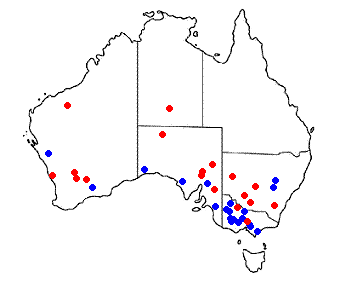 |
The map (above right) shows the distributions of the mosses Microbryum brevicaule (red dots) and Tortula willissiana (blue dots). These are further examples of species that seem to be widespread in the inland areas, with Tortula willissiana seemingly confined to the southern half of Australia. You can see that the distributions of the two are a little patchy, for the inland areas where both species are likely to be more widespread have not been well-explored bryologically.
 Across the north
Across the north
Tropical Australia has not been well-explored from a bryological perspective. North-east Queensland is better known bryologically than the area from the Gulf Country through to the Kimberley in Western Australia. The AUSTRALIA AND ELSEWHERE page noted that, in northern Australia (especially north-east Queensland), you can find quite a number of pantropical and paleotropical species as well as many that are continental Asian to Pacific in distribution. However there are also species that, on current knowledge, are endemic to northern Australia. Not surprisingly the majority of those are so far known only from north-east Queensland and you've seen some examples above.
In this section we'll look at species found west of the Great Dividing Range. The hornwort Anthoceros capricornii is found in the north of the Northern Territory and Western Australia. The species has not been found over as extensive a distance as say the Dawsonia species noted above. However, the distance between the eastern and western extremities of the Anthoceros distribution is about 800 kilometres. The moss Fissidens victorialis is also known from somewhat similar areas in the north of the Northern Territory and Western Australia. Fissidens gymnocarpus is known from the north Queensland coast to the Kimberley Coast. There is also a report of this species from the Brisbane area. The thallose liverwort Riccia caroliniana has been found over a large area in the northern part of the Northern Territory and near Croydon a little south-east of the Gulf of Carpentaria. The accompanying maps show, from top to bottom, the distributions of Anthoceros capricornii, Fissidens gymnocarpus and Riccia caroliniana![]() .
.
Nullarbor or Bass Strait disjuncts
An earlier map showed that Ephemerum cristatum and Asterella drumondii are found either side of Bass Strait and there are other endemic species that are found on each side of Bass Strait. A good proportion of those are confined to the south-east on the mainland. There's also a reasonable number of endemic bryophytes that are found in both eastern Australia and Western Australia but not in between. For many of those their western distributions are confined to the south-west of Western Australia.
Telaranea grossiseta , a leafy liverwort, is known from a number of sites in the wetter, western half of Tasmania and from one location in New South Wales - a specimen collected along the Macquarie River in 1836. Kurzia dendroides, another leafy liverwort, is known from Tasmania and from the Blue Mountains near Sydney in New South Wales. That species features in the illustration at the head of this page. The thallose liverworts Aneura rodwayi and Treubia tasmanica and the leafy liverwort Telaranea consobrina are found in Victoria and Tasmania. Temnoma townrowii, another leafy liverwort, has been found in Tasmania, Victoria, the Australian Capital Territory and south-eastern New South Wales and Radula novae-hollandiae, yet another leafy liverwort, is known from Tasmania, New South Wales and Queensland. The moss Breutelia pseudophilonotis is found in Tasmania, Victoria, the Australian Capital Territory and in New South Wales north to about the Coffs Harbour latitude. Dicranoweisia microcarpa, another moss, is found in Tasmania and Victoria. Calyptrochaeta otwayensis is a moss that doesn't quite make it across Bass Strait. It is known from the Otway Ranges, south-west of Geelong in Victoria and from King Island in Bass Strait.
The map (below left) shows the distributions of the mosses Gemmabryum austrosabulosum (red dots) and Gemmabryum sullivanii (blue dots). The former often grows on exposed rocks, even sand dunes, while the latter grows mainly on damp soil or rocks near streams and often on limestone.
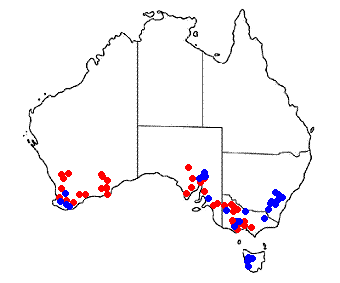 |
 |
The moss Acaulon granulosum (blue dots on the map above right) is known from Victoria and Western Australia and, as the map shows, is found in the drier areas. Bartramia pseudostricta (red dots) is known from South Australia and western Australia. In contrast to these species, many of the eastern/western Australian disjunctive mosses are found along the Great Dividing Range in the east.
The mosses Gemmabryum cheelii and Philonotis australiensis are known from south-west Western Australia, south-eastern South Australia, Victoria and Tasmania (with Gemmabryum cheelii also found in south-east New South Wales.
Odds and ends
 This page started with examples of puzzles in Australian bryogeography – species known from very limited areas. There are also some puzzles at the other extreme - bryophytes that are fairly widely distributed but which don't fall into any of the patterns noted above. Therefore this final section serves both to show that there's still more to Australian bryogeography and to present you with some of the many puzzles that still remain. Speaking of puzzles, there's more about that subject in the PROBLEMS AND PUZZLES page.
This page started with examples of puzzles in Australian bryogeography – species known from very limited areas. There are also some puzzles at the other extreme - bryophytes that are fairly widely distributed but which don't fall into any of the patterns noted above. Therefore this final section serves both to show that there's still more to Australian bryogeography and to present you with some of the many puzzles that still remain. Speaking of puzzles, there's more about that subject in the PROBLEMS AND PUZZLES page.
The moss Rosulabryum queenslandicum is known from three areas in eastern Queensland and from one location in the Northern Territory. The open circle indicates a specimen that was collected in Deua National Park in south-east New South Wales and identified, by an expert in Rosulabryum, as close to the species Rosulabryum queenslandicum. Is it in fact that species and what is the real distribution of the species? There are considerable gaps between the locations where the moss has been found.
 Riella is a genus of saline-tolerant thallose liverworts and the two species known from Australia, Riella halophila and Riella spiculata, are both endemic and have been found in Victoria and South Australia. In Victoria Riella halophila has been found near Port Londsdale and in the Big Desert region and, in South Australia it has been found at Dalhousie Springs, towards the Northern Territory border. A specimen of Riella, tentatively identified as Riella spiculata, has been found at Dalhousie Springs. Otherwise, Riella spiculata is known only from a site near Portland in south-western Victoria. The thallose liverwort Petalophyllum preissii
Riella is a genus of saline-tolerant thallose liverworts and the two species known from Australia, Riella halophila and Riella spiculata, are both endemic and have been found in Victoria and South Australia. In Victoria Riella halophila has been found near Port Londsdale and in the Big Desert region and, in South Australia it has been found at Dalhousie Springs, towards the Northern Territory border. A specimen of Riella, tentatively identified as Riella spiculata, has been found at Dalhousie Springs. Otherwise, Riella spiculata is known only from a site near Portland in south-western Victoria. The thallose liverwort Petalophyllum preissii ![]() was first collected in the 1800s near the Swan River in Western Australia but is also known from sandy or somewhat saline soils at a few coastal or near coastal areas in South Australia and Victoria. The full map of Australia shows the distribution of Petalophyllum preissii (red dots) as well as that of another thallose liverwort, Enigmella thallina (blue dots)
was first collected in the 1800s near the Swan River in Western Australia but is also known from sandy or somewhat saline soils at a few coastal or near coastal areas in South Australia and Victoria. The full map of Australia shows the distribution of Petalophyllum preissii (red dots) as well as that of another thallose liverwort, Enigmella thallina (blue dots) ![]() . The partial map shows the distributions of Riella halophila (red) and Riella spiculata (blue).
. The partial map shows the distributions of Riella halophila (red) and Riella spiculata (blue).
Enigmella thallina, the only species in the genus, is unusual in that it has been described as a leafy thallose liverwort. The thallus may develop small, leafy appendages but more often grows as a flat thallus, typically only about 5 millimetres in length and flush with or partially buried in the soil. The size and cryptic nature of the species make it easy to understand that it could easily be overlooked. Petalophyllum dies down to a tuber at the end of the growing season, after the spores have been released. All the species in the genus Riella seem ephemeral, the gametophytes typically developing in seasonal ponds and disappearing shortly after such ponds dry out, leaving spores to produce new plants when suitable conditions return. It is therefore not surprising that Petalophyllum and Riella are seen rarely![]() .
.
![An Australian Government Initiative [logo]](/images/austgovt_brown_90px.gif)


